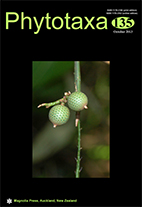Abstract
Eight Brazilian Atlantic Rainforest species are described and illustrated: Calyptranthes santalucia, Eugenia barrana, E. culicina, E. lacistema, E. viscacea, Myrcia basicordata, M. monoclada and Myrciaria evanida. Calyptranthes santalucia, from the state of Espírito Santo, is related to C. brasiliensis, differing for its acute leaves and pauciflorous inflorescences; Eugenia barrana, from the states of Minas Gerais and Bahia, is related to E. chlorophylla, but has smaller leaves and larger flowers; Eugenia culicina, from the state of Pernambuco, is related to E. roseiflora, differing through the smaller petioles, adaxially sulcate lateral veins, pilose flowers and larger fruits; Eugenia lacistema, from Bahia, is related to E. platyphylla, differing by the inflorescences with lignified bracts and smaller pedicels; Eugenia viscacea, from Bahia, is related to E. ellipsoidea, differing through the inflorescences with densely imbricate bracts and smaller pedicels; Myrcia basicordata, from Espírito Santo, is related to M. pubescens, but presents applanate glabrous twigs and glabrous and sessile leaves with cordate base; Myrcia monoclada, from Bahia, is related to M. riodocensis, but has larger leaves and pentamerous flowers, and Myrciaria evanida, from Espírito Santo and Minas Gerais, resembles M. floribunda, differing by the vanishing secondary veins and smaller flowers. The new species are also evaluated as to their conservation status according to IUCN criteria. Additionally, the synonymization of Eugenia apiocarpa under E. astringens and of Eugenia pleurantha under E. umbellata and the lectotypification of Eugenia ellipsoidea are proposed.

